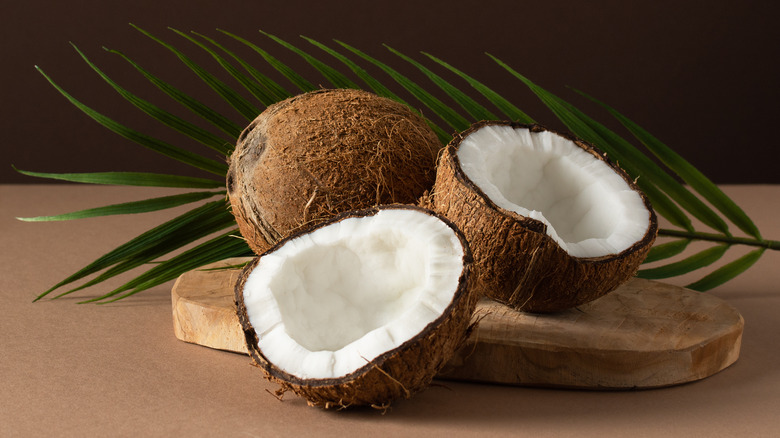What To Look For When Buying Fresh Coconut (And Signs It's Past Its Prime)
For some people, the coconut is a bit of a mystery. What is it? Can you call it a fruit? Is it in a category all its own? And how do you eat one? In fact, a coconut does it all as a nut, a seed, and a fruit; however, it's technically a dry drupe because of its hard covering. Whatever the coconut is, people love its flavor, and for many of us who don't live in a "coconut climate," we love what a rarity it is. Still, there is more to your raw coconut than its taste and uniqueness.
One coconut supplies everything you need for your favorite coconut cake recipe, a hearty snack, the toasted coconut on your salad or seafood, coconut water to drink, and even coconut oil for use on your skin or in food recipes. Like many natural foods you eat, the coconut has some health benefits — just 1 cup contains over 20% of your daily fiber needs and 60% of your body's daily manganese requirements.
The tropical coconut is healthy and tasty, but there's one small problem: If you don't buy coconut often, it's intimidating trying to choose one at the grocery store. With its large size, heavy weight, and hard, somewhat stringy covering, it's a mystery as to what you're looking for.
Choosing your coconut
When choosing the right coconut, start with your hands and pick it up to feel the weight. A good, fresh coconut has a solid, heavy weight to it. When a coconut gets old, it starts to dry up, and when you hold it, it feels light. While you're holding the coconut, pay attention to how the fibers feel on the shell. The fibers are that brown stringy stuff all over the coconut. They sometimes look dry; however, you want a coconut with moist, damp-feeling fibers, which tell you the coconut is fresh, ripe, and full of moisture.
Coconuts naturally have water inside of them, and people enjoy drinking it straight from the coconut or adding it to recipes. However you choose to use it, you certainly don't want a dried-out coconut with no delicious coconut water inside. The best way to tell if it's full of water is to put the coconut up to your ear. Sure, you may look a little silly in the grocery store, but most people will assume you're a professional and watch in awe. Give the coconut a shake and listen for water sloshing around. If you don't hear anything, then the water has likely dried up.
Dry fibers, light weight, and no signs of water are reliable indicators that a coconut isn't any good. However, if it's moist on the outside, feels like it's got some weight to it, and has liquid rolling around inside, you've found a ripe coconut that's ready to be cut open and enjoyed.

